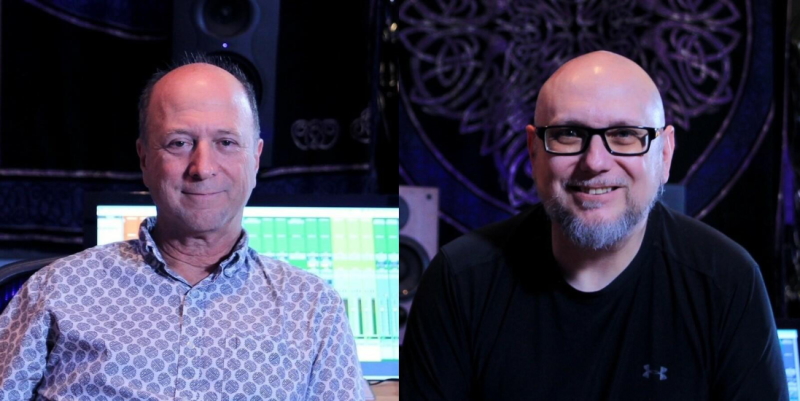Recording Academy P&E Wing "The Forum" Series

L-R: Matt Wallace, Will Kennedy
The Recording Academy Producers & Engineers Wing recently hosted the first episode of its new online series dubbed "The Forum," which aims to connect P&E Wing members with exclusive insights on an array of the industry's hottest topics. Titled "Mixing for Atmos® – What We've Learned," the event initially took place on March 28 and attracted more than 180 P&E Wing members who tuned in for the live session, which has now been archived for public viewing and is available here). The two-hour segment, hosted by producer/engineers Glenn Lorbiecki and Jordan Hamlin, was an in-depth exploration with the mixing team of Matt Wallace and Will Kennedy, whose immersive projects include work ranging from Dave Matthews Band, Foreigner and the B-52s to Selena Gomez, Nina Simone, Jason Mraz, and many more. This lauded duo has helped pioneer immersive audio mixing with over 200 Dolby Atmos® projects to their credit. P&E Wing Vice President Maureen Droney introduced the event, welcoming attendees and offering background and info for the session's esteemed hosts.
Discussion began with an overview of the extensive credits garnered by the duo, ranging from classic recordings from their decades-long careers to their adoption of the Atmos mixing ecosystem. "As we made the transition from stereo mixing into Atmos, the learning curve was exponential and much more beyond what we had imagined," recalled Wallace. "And, because there were no kind of rules or guidebooks or guide rails, and no elder statesman we could refer to and say, 'Hey, how do you do this?' We had to make it up as we went along - new software, new technology. I think all of us [the whole industry] were basically thrown in the deep end," he added, noting the invaluable support of the informal "Dolby Atmos Mixers Network" of fellow engineers sharing their own discoveries.
"In the beginning, there were fewer than 20 Atmos music studios, maybe even fewer than that in the world. And so that many people were doing the work, and nobody had a depth of experience," stated Kennedy. "And in terms of what we had to throw away from stereo – you start doing all the things that you're used to doing that work nearly all the time for you in stereo, and it falls apart in Atmos. And then you go, well, 'I thought that I understood how to build this house, but now I've got to sort of tear it all down to the foundation' and go, 'okay, is this working?'"
Looking back on one of their most difficult early mixes in the Atmos format, Wallace describes breakthroughs made while mixing the B-52s' hit "Love Shack": "We found out that you do have to be kind of front-stage centric. You've got to have the foundational elements there, and then you can gently spread things out. Specifically, we spread out the ambient vocal tracks, and there's some horn stuff and things like that, but we really had to learn how to very judiciously open things up." He continues, "When you're working with catalog stuff, and especially something like 'Love Shack,' which is a song that is beloved and internationally known, nobody came knocking on our door going, 'Hey, Matt, Will, could you put your stamp on "Love Shack"?' What they wanted was something that would make people feel that nostalgic feeling. So it was a process of learning: how do we make something where, if you listen to the stereo and compare it to the Atmos, you will hear a different sense of space and a different perspective, but without taking away the vibe."
Referencing another revelation while recording a basic musical element, such as an acoustic guitar, Wallace shared, "If we're mixing it in stereo for a heavy rock track, we're going to high-pass-filter that acoustic guitar with all the heavy metal guitars in there, so it basically sounds like a tuned tambourine. You're going to hear the top end of that acoustic. If you solo it, you're going to go, 'That sounds terrible.' But in the mix, it sounds like an acoustic guitar. Because once you get into Atmos, you can bring back all the body of the guitar. It has its own space and it becomes a very different-sounding instrument. With Atmos, we're really bringing back, what I believe, is fidelity."
Kennedy added, "The technology is fascinating. It's a lot of fun to learn, and I love diving in on the technical side of stuff. But, if it's not going to deliver a listener a better experience than what they can get from the technology that already exists, what are we doing? The whole point of music is the emotional experience. And that's the thing that got us both on board."
The pair went on, in-detail, about a number of other Atmos-related insights, referencing top tracks from their careers, along with discussion of the latest consumer technologies, content delivery, and the overall importance of maintaining the intended feel of the music for the listener. The event concluded with a lively Q&A with the online attendees. Complete video of this first The Forum series event, "Mixing for Atmos – What We’ve Learned," is available here, with further events to be announced soon.
 How to resolve AdBlock issue?
How to resolve AdBlock issue?